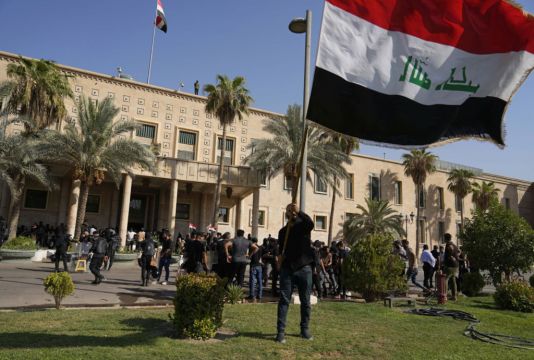Armed supporters of a powerful Iraqi cleric who clashed with security forces in the capital have begun to withdraw from the streets, restoring a measure of calm after a serious escalation of the nation’s political crisis.
Following two days of deadly unrest that sparked fears instability might spread throughout the country and even the region, cleric Muqtada al-Sadr told his supporters to leave the government quarter in Baghdad where they had rallied.
Within minutes, some could be seen heeding the call, dismantling their tents and walking out of the area known as the Green Zone.
Iraq’s military also announced the lifting of a nationwide curfew, further raising hopes that the immediate crisis was ebbing, though larger political problems remain.

The unrest began on Monday, when Mr al-Sadr announced he would resign from politics and his supporters stormed the Green Zone in Baghdad, once the stronghold of the US military that is now home to Iraqi government offices and foreign embassies.
At least 30 people have been killed, officials said.
“This is not a revolution,” Mr al-Sadr said in a televised address, which followed pleas for restraint and peace from several Iraqi officials and the United Nations.
Prime Minister Mustafa al-Kadhimi threatened to vacate his post if the political crisis continues.
In a speech on Tuesday evening, he said an investigative committee had been formed to uncover who shot at Mr al-Sadr’s supporters on Monday, “despite our clear and strict orders prohibiting the use of live ammunition”.
“It is also imperative to determine who opened fire and launched rockets and mortars on governmental institutions throughout the night,” he added. “Undisciplined groups will face legal consequences.”
Iraq’s government has been deadlocked since Mr al-Sadr’s party won the largest share of seats in October parliamentary elections but not enough to secure a majority government – unleashing months of infighting between different Shiite factions.
Mr al-Sadr refused to negotiate with his Iran-backed Shiite rivals, and his withdrawal on Monday catapulted Iraq into political uncertainty.
Iran closed its borders to Iraq on Tuesday – a sign of Tehran’s concern that the chaos could spread, though streets beyond the capital’s government quarter largely remained calm.
The country’s vital oil continued to flow, with global benchmark Brent crude trading slightly down.
Earlier on Tuesday, supporters of Mr al-Sadr could be seen on live television firing both machine guns and rocket-propelled grenades into the heavily fortified area through a section of pulled-down concrete walls.

Security forces armed with machine guns inside the zone sporadically returned fire.
Some bystanders filmed the gunfight with their mobile phones, though most hid behind still-standing segments of wall, wincing when rounds cracked nearby.
As Mr al-Sadr’s forces fired, a line of armoured tanks stood on the other side of the barriers that surround the Green Zone, though they did not use their heavy guns.
At least one wounded man from Mr al-Sadr’s forces was taken away in a three-wheel rickshaw, with the Iraqi Foreign Ministry visible in the background.
Heavy black smoke at one point rose over the area, visible from miles away.
At least 30 people have been killed and more than 400 wounded, two Iraqi medical officials said.
The toll included both al-Sadr loyalists killed in protests the day before and clashes overnight.

Those figures are expected to rise, said the officials.
Members of Iraq’s majority Shiite Muslim population were oppressed when Saddam Hussein ruled the country for decades.
The 2003 US-led invasion that toppled Saddam, a Sunni, reversed the political order.
Just under two-thirds of Iraq is Shiite, with a third Sunni.
Now, the Shiites are fighting among themselves after the Americans largely withdrew from the nation, with Iranian-backed Shiites and Iraqi-nationalist Shiites jockeying for power, influence and state resources.
It is an explosive rivalry in a country where many remain way of the Iranian government’s influence even though trade and ties remain strong between its peoples.

Iraq and Iran fought a bloody war in the 1980s that saw a million people killed.
Mr al-Sadr’s nationalist rhetoric and reform agenda resonates powerfully with his supporters, who largely hail from Iraq’s poorest sectors of society and were historically shut out of the political system under Saddam.
His announcement that he is leaving politics has implicitly given his supporters the freedom to act as they see fit.
Iranian state television cited unrest and a military-imposed curfew in Iraqi cities for the reason for the border closures.
It urged Iranians to avoid any travel to the neighbouring country.
The decision came as millions were preparing to visit Iraq for an annual pilgrimage to Shiite sites, and Tehran encouraged any Iranian pilgrims already in Iraq to avoid further travel between cities.

Kuwait, meanwhile, called on its citizens to leave Iraq.
The state-run KUNA news agency also encouraged those hoping to travel to Iraq to delay their plans.
The tiny Gulf Arab sheikhdom of Kuwait shares a 254-kilometre (158-mile) long border with Iraq.
The Netherlands evacuated its embassy in the Green Zone, foreign affairs minister Wopke Hoekstra tweeted early on Tuesday.
“There are firefights around the embassy in Baghdad. Our staff are now working at the German embassy elsewhere in the city,” Mr Hoekstra wrote.
Dubai’s long-haul carrier Emirates stopped flights to Baghdad on Tuesday over the ongoing unrest.
The carrier said that it was “monitoring the situation closely”.

It did not say when flights would resume.
On Monday, protesters loyal to Mr al-Sadr pulled down the cement barriers outside the government palace with ropes and breached the palace gates.
Many rushed into the lavish salons and marbled halls of the palace, a key meeting place for Iraqi heads of state and foreign dignitaries.







